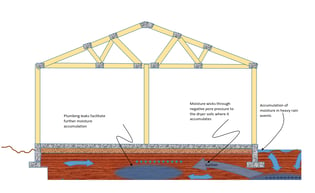Foundation Type: Pier & Beam
The last type of foundation system I would like to discuss is the crawlspace foundation, or sometimes referred to as a pier and beam. These are more common in colder climates and in the southwest, older homes (mostly built before the 1960s). Illustration below.
.png?width=535&name=RoT%20VI%20(1).png)
As you might deduce from prior discussions, because there are only concentrated loads with no slabs, the opportunities for heave are greatly diminished and for settlement to be a more likely outcome. There are portions of these homes that have slabs on grade that connect up to it such as garages, patios and sidewalks. These slabs are more vulnerable to heave and could move differently than the portions of the home without slabs on grade.
I have seen footings on the perimeter heave, however as discussed in my previous blog Rules of Thumb Part 4, footings have concentrated roof loads and are not as wide a slabs, hence less likely to heave.
If the footings are heaving, then it is either very expansive soil and/or is lower down using the soil above to spread the bridging force upward.
It is common with older foundations that there are no trusses to spread the roof loads only to the perimeter footings. In those situations there are interior walls that pass the roof load down to jacks under the crawlspace. Because of this interior floors can have settlement more easily.
Also with the roof loads spread out more to many more points, the loads are not as concentrated and could be more likely to see heave than if there are trusses concentrating the loads to only the perimeter. With Trusses, the interior jacks under the floor only have floor loads on them making them more likely for have than settle.
To summarize, follow the weight! Where there are concentrated loads, settlement is more likely than heave. The more load the more likely. Conversely, with lighter loads, heave is more likely. When slabs are connected to structure with only footings touching the soil, there could be opportunities for separate or even opposite movement.
Next: Rules of Thumb VII: https://www.foundationaz.com/blog/rules-of-thumb-in-diagnosing-foundation-problems-part-vii-the-age-of-the-structure
Previous: Rules of Thumb V: https://www.foundationaz.com/blog/rules-of-thumb-for-diagnosing-foundation-failure-part-v-the-truth-about-pt






